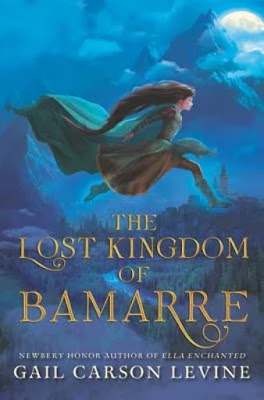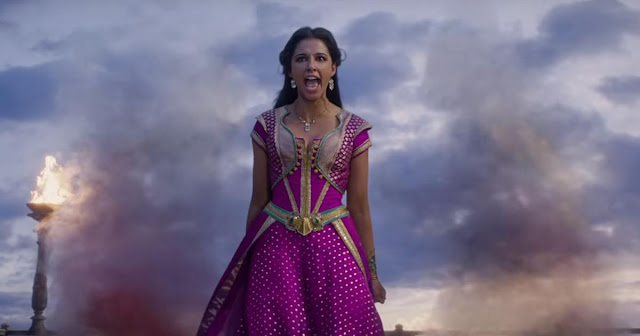Review: The Lost Kingdom of Bamarre
It's no secret that I am a big fan of Gail Carson Levine's work. I read all of her books when I was in high school and college. Just a few months ago, she published a prequel to The Two Princesses of Bamarre. I haven't read that book in many years, so my memory of it is vague, but there were some magical items in The Lost Kingdom of Bamarre that I recalled from The Two Princesses of Bamarre such as the boots that travel seven leagues in a single step and the table cloth that can create infinite food. Other than the enchanted relics, The Lost Kingdom of Bamarre is a terrific stand-alone story that has little to do with The Two Princesses of Bamarre. It shares some similarities to the "Rapunzel" fairy tale in the same way that Fairest does with "Snow White" and Ella Enchanted with "Cinderella." Mostly, though, it is a metaphor for the treatment of the Jewish people during World War II.
In The Lost Kingdom of Bamarre, Peregrine is a girl who was stolen from her family as a baby and raised by adoptive parents to be a Lakti. The Lakti are conquerors of lands who look down on the Bamarre, who are the people they persecuted after helping the Lakti to escape dangers in the neighboring lands, much like how the Europeans persecuted the Native Americans after being welcomed by their people. Perry is happy with her Lakti life, her loving adoptive father, and her Bamarre nursemaid, Annet, until one day, a fairy named Halina appears to her and reveals that she is a Bamarre. This revelation completely changes the way that Perry sees the world. She realizes that the Bamarre are not so different from the Lakti after all and that her adoptive father's love for her is conditional. Halina entrusts her with the mission of freeing the Bamarre from the Lakti's tyranny, a mission that Perry is uncertain about at first. The book is a wonderful metaphor for prejudice and racism, though it does not come off as preachy.
Gail Carson Levine is Jewish like me, and I was able to clearly see the metaphors for Judaism in this novel. During the Holocaust, Jews were forced to wear the Star of David when in public so that everyone around them could see that they were Jewish and have an excuse to mistreat them. In The Lost Kingdom of Bamarre, the Bamarre were forced to wear caps with tassels on them, giving the Lakti free reign to treat them like second class citizens. Because the book is told from the perspective of Perry, who was raised as a Latki, it is impossible to see the Lakti as completely evil. Shades of grey exist when people brought up a certain way and don't know they are doing wrong until they taught otherwise. Perry did not hate the Bamarre, but she did see them as inferior, like the Jews during the Holocaust, before she was told that she was one of them. My ancestors, like many Jews, escaped to Ellis Island during the Holocaust where they would be treated as equals in America. In this novel, Perry helps to lead the Bamarre into the dangerous land of Old Lakti, where they can start their lives over again without the tyranny of the Latki.
The fairy tale influence in the book was brief, but entertaining. Just as Ella Enchanted poses the question "What if Cinderella only did what she was told because she was under a curse?" and Fairest asks "What if Snow White wasn't the fairest one of all?" The Lost Kingdom of Bamarre asks "What if Rapunzel suffered from claustrophobia while she was locked in the tower?" Like Rapunzel, Perry also has a love interest who climbs her enchanted red hair, but Willem is a passive hero. As usual for Gail Carson Levine's books, all of the action is left to the heroine. In many ways, it was a dark tale, especially for Gail, but the fantasy elements peppered throughout the book kept the mood from getting too grim. Perry's adoptive mother gives her two magical relics to help her on her quest, and she steals a third from a rival kingdom. Later in the book, Halina casts a spell on Perry that proves far more interesting than cursed hair and takes the story in a direction that is similar to Mulan.
Overall, The Lost Kingdom of Bamarre is an exciting adventure story full of suspense that is empowering for girls with an important message about the way we treat people. Those who grew up Jewish like me will have a special appreciation for this book, but it can be enjoyed by anyone. It is a very unique take on the story of "Rapunzel" as well as a dark war story with light fantasy undertones. As a prequel, it has little in common with The Two Princesses of Bamarre, but it is a worthy addition to Gail Carson Levine's other books about princesses and fairies.
In The Lost Kingdom of Bamarre, Peregrine is a girl who was stolen from her family as a baby and raised by adoptive parents to be a Lakti. The Lakti are conquerors of lands who look down on the Bamarre, who are the people they persecuted after helping the Lakti to escape dangers in the neighboring lands, much like how the Europeans persecuted the Native Americans after being welcomed by their people. Perry is happy with her Lakti life, her loving adoptive father, and her Bamarre nursemaid, Annet, until one day, a fairy named Halina appears to her and reveals that she is a Bamarre. This revelation completely changes the way that Perry sees the world. She realizes that the Bamarre are not so different from the Lakti after all and that her adoptive father's love for her is conditional. Halina entrusts her with the mission of freeing the Bamarre from the Lakti's tyranny, a mission that Perry is uncertain about at first. The book is a wonderful metaphor for prejudice and racism, though it does not come off as preachy.
Gail Carson Levine is Jewish like me, and I was able to clearly see the metaphors for Judaism in this novel. During the Holocaust, Jews were forced to wear the Star of David when in public so that everyone around them could see that they were Jewish and have an excuse to mistreat them. In The Lost Kingdom of Bamarre, the Bamarre were forced to wear caps with tassels on them, giving the Lakti free reign to treat them like second class citizens. Because the book is told from the perspective of Perry, who was raised as a Latki, it is impossible to see the Lakti as completely evil. Shades of grey exist when people brought up a certain way and don't know they are doing wrong until they taught otherwise. Perry did not hate the Bamarre, but she did see them as inferior, like the Jews during the Holocaust, before she was told that she was one of them. My ancestors, like many Jews, escaped to Ellis Island during the Holocaust where they would be treated as equals in America. In this novel, Perry helps to lead the Bamarre into the dangerous land of Old Lakti, where they can start their lives over again without the tyranny of the Latki.
The fairy tale influence in the book was brief, but entertaining. Just as Ella Enchanted poses the question "What if Cinderella only did what she was told because she was under a curse?" and Fairest asks "What if Snow White wasn't the fairest one of all?" The Lost Kingdom of Bamarre asks "What if Rapunzel suffered from claustrophobia while she was locked in the tower?" Like Rapunzel, Perry also has a love interest who climbs her enchanted red hair, but Willem is a passive hero. As usual for Gail Carson Levine's books, all of the action is left to the heroine. In many ways, it was a dark tale, especially for Gail, but the fantasy elements peppered throughout the book kept the mood from getting too grim. Perry's adoptive mother gives her two magical relics to help her on her quest, and she steals a third from a rival kingdom. Later in the book, Halina casts a spell on Perry that proves far more interesting than cursed hair and takes the story in a direction that is similar to Mulan.
Overall, The Lost Kingdom of Bamarre is an exciting adventure story full of suspense that is empowering for girls with an important message about the way we treat people. Those who grew up Jewish like me will have a special appreciation for this book, but it can be enjoyed by anyone. It is a very unique take on the story of "Rapunzel" as well as a dark war story with light fantasy undertones. As a prequel, it has little in common with The Two Princesses of Bamarre, but it is a worthy addition to Gail Carson Levine's other books about princesses and fairies.












Comments